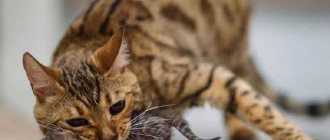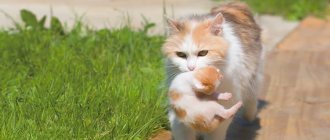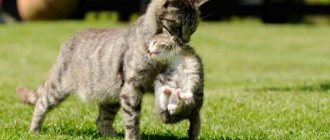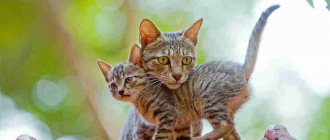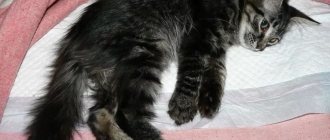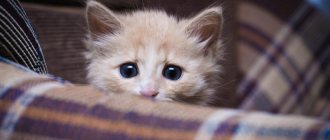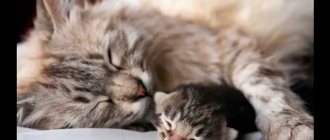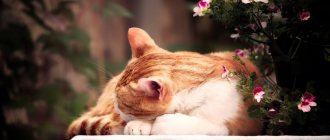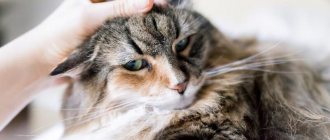Maternal instinct is an innate behavior pattern of an animal that ensures procreation. In cats, it usually works flawlessly. From the moment the cubs are born, mothers show maximum attention to the kittens, feeding them, washing them and protecting them from potential dangers. Often even from a person.
But, unfortunately, there are no rules without exceptions. Sometimes cats simply abandon their maternal responsibilities, dooming their newborns to starvation. But why does a cat leave newborn kittens? What principles underlie refusal of motherhood? And is it possible to save abandoned cubs if the mother cat still abandons them? First things first.
How to reduce the risk of abandonment of offspring
Try to follow the basic rules:
- the cat should have a warm and quiet place for giving birth and subsequent feeding of kittens;
- the cat should eat food high in nutrients;
- there is no need to touch kittens in the first two weeks of their life unless necessary;
- other pets should not have access to the cat with kittens, including the cat.
If the cat does abandon the little kittens, there are other possible reasons:
- the cat is too young and this is her first birth;
- too many kittens;
- after giving birth, the cat developed complications, for example, mastitis;
- the cat has no milk;
Contact your veterinarian for advice. Try to feed the cat food with a high content of nutrients, move her house to a quiet and peaceful place - perhaps after a short time the maternal instinct will kick in and she will return to her cubs.
Why is this happening?
Atypical behavior of a mother cat appears for various reasons: - illness;
- lack of milk; - stress; - young age; — foreign smell; - non-viability of babies; - spoiled; - estrus after childbirth; - hormonal disbalance. The most common cause is illness. Pregnancy and childbirth are a big burden on the body, which often has disastrous consequences. A young mother most often develops: - mastitis - inflammation of the mammary glands; - eclampsia - lack of calcium (accompanied by convulsions); - endometritis - inflammation of the uterus.
After a difficult birth, it is difficult for a cat to return to its previous state. Weakness and pain make you run away and hide. Treatment of a cat should be entrusted to a veterinarian.
Childbirth is also a lot of stress. The cat needs to be reassured, be close and create a feeling of security. Fussiness around, an uncomfortable or cold place to hide also worsens the animal’s condition.
Most mammals develop sexual instinct first, and then maternal instinct. A young cat is hormonally ready to mate, but is not ready to care for offspring. Therefore, do not rush to breed a young cat.
Spoiled individuals do not bother themselves with caring for their offspring. They have an all-powerful person who can handle this task. Excessive care “turns off” the maternal instinct in a cat.
Behavior may change due to hormonal imbalance. For example, the onset of estrus signals readiness for a new mating, which does not correspond to maternal instinct. This can even happen to cats who are not mothers for the first time. Due to illness or hormonal imbalance, milk often disappears.
How to feed a kitten
Unfortunately, such measures do not always lead to the return of the mother to her offspring. You will have to take on the responsibilities of being a mother. The best option would be to give the kittens to be raised by another cat that has just given birth. If you cannot find a nursing cat, you will have to try to feed the kittens at home.
- How to properly feed a kitten without a mother? First of all, you need to purchase a special mixture for newborn kittens at a pet store. The composition of such mixtures is very similar to mother's cat milk. Under no circumstances should you feed your kitten natural cow's milk: it is very different in composition from cat's milk and can lead to intestinal problems.
- Before feeding the kitten, you need to stimulate it: stroke its head, back, and tummy, imitating maternal licking.
- The temperature of the feeding mixture should be 36–38°C. Before feeding your kitten, place a drop of the mixture on your wrist to check the temperature. It is best to feed your kitten using a disposable syringe without a needle - this way you can control the portion size.
- In the first week of life, kittens need to be fed every 2 hours. In the second week, the frequency of feedings is reduced to 8 times a day. From the third week, kittens need to be fed only during the day, but at least 6 times a day.
- How much should a kitten eat? Pay attention to his behavior. A full-fed kitten falls asleep almost immediately. If there is not enough food, the kitten will continue to squeak and poke at your hands in search of a pacifier.
- After each feeding, the cat licks her litter to stimulate digestion and help the kittens go to the toilet. After each feeding, you will have to wipe the kitten's belly and butt with a soft cloth soaked in warm water.
What and how to feed blind kittens without a cat: recipes for mixtures
Cow's milk is not suitable for feeding and does not contain all the nutrients.
What and how to feed blind kittens without a cat, formula recipes:
- A mixture of cow's milk with eggs and vegetable oil . For approximately 220 ml of cow's milk you need 2 chicken yolks and 50 ml of vegetable oil. It is better to take refined one. This whole mixture is shaken and heated in a water bath to a temperature of 35 degrees. This mixture can be fed to kittens.
- You need to dilute 400 ml of condensed milk without sugar with water and add about two tablespoons of bone meal. The mixture is shaken and heated before feeding. If you don’t want to prepare anything, you can safely use mixtures that are sold in veterinary clinics. However, their cost is quite high, so not everyone can afford to purchase such products.
Please note that it is also necessary to accurately calculate food standards for babies. Under no circumstances should you overfeed. On average, about 4-5 ml of formula is needed per 100 g of kitten. If the kitten weighs 250 g, the optimal amount is 10 ml of mixture. Prepare the mixture for one day, store in the refrigerator. Never use two-day formula to feed babies.
Homeless
Self-feeding kitten
At the age of three weeks, you can begin to introduce complementary foods into the kittens' diet. To avoid causing digestive disorders, portions should be very small, about the size of a pea.
What can and cannot be fed to kittens?
Can:
- food of soft and delicate consistency for kittens, preferably in the form of mousse.
It is forbidden:
- raw meat and fish;
- fatty, salty and fried foods;
- chocolate and sweets;
- food from your table.
How often should you give your kitten food? After introducing complementary foods, the frequency of feedings can be gradually reduced. In any case, consult your veterinarian regarding nutrition and introduction of complementary foods.
How to syringe feed a newborn kitten?
We'll have to prepare for sleepless nights feeding the babies. Newborn kittens are not able to lap up milk on their own; they must be fed with a syringe or pipette.
How to syringe feed a newborn kitten:
- It is necessary to squeeze out the milk little by little, drop by drop. There is no need to insert a syringe into your mouth; you need to place the tip on your lower lip and apply pressure.
- Gradually, drop by drop will appear, and the kitten will lick off the food.
- You should not dip your baby's face into the mixture; it can get into the respiratory tract, which can cause suffocation.
Feeding kittens
Creating conditions for kittens
To raise a kitten without a cat, you will have to replace the mother not only in the feeding process. You need to provide the kittens with a place to sleep and play, learn how to wash the kitten, and give it a massage.
- A place to sleep. You can use a small box as a sleeping place. Place soft cloths, baby diapers or towels there. During the first weeks of life, the temperature of the kittens' bed should be similar to the mother cat's body temperature. The room temperature will need to be maintained at 29-32°C, then gradually reduced to 24°C. If kittens are cold, use a warm water bottle or a small heater as a heating pad. The sleeping area should be clean, so wash the bedding promptly, being careful not to use chemical cleaners.
- Washing and massage. It is best to wash the kitten with a cotton pad or soft cloth soaked in warm water. When washing, imitate the movements of a mother cat - move along the kitten’s fur in one direction, from top to bottom. Before and after each feeding, it is necessary to massage the kitten's tummy to stimulate digestion and bowel movements.
What to do
- If the cat abandoned the kittens immediately after birth, then you need to give them colostrum - the first milk that the cat produced after giving birth.
- Keep kittens warm.
- Prepare them a special milk formula (not cow's milk) and feed them on a very busy schedule.
- Make sure they gain weight.
- Wash them with a sponge soaked in warm water and massage their tummy.
In any case, you need to try to solve the problem with the cat and take it to the veterinarian. Maybe the problem lies in her health, and something can be done about it. You can also try to find a surrogate mother for the kittens - a cat who has recently given birth and is ready to shelter other people's kittens.
You may also be interested in the following articles:
- Why are cats afraid of cucumbers?
- Why do cats curl up in a ball when they sleep?
Visits to a veterinarian
If you have any questions about caring for kittens, please contact your veterinarian. He will tell you all the nuances, talk about vaccinations and check the pet’s health. Be sure to visit the clinic if something in the kitten’s behavior or appearance confuses you. Reasons for visiting a veterinarian may include discharge from the kitten's eyes or nose, unusual lethargy, lack of appetite, unusual stool, and injuries.
Caring for newborn kittens is a difficult and responsible task, but with proper attention and patience, you will be able to feed and raise them.
Features of cat psychology after childbirth
It is physiologically determined that cats have a highly developed maternal instinct. Psychology is based on natural mechanisms, and not on generally accepted human moral principles. It is not advisable to be surprised by the cat or try to punish her by appealing to prudence if she left the kittens.
Animal psychologists identify several reasons why a cat may abandon newborns:
- Youth. Having become a mother at an early age, a cat may not be psychologically mature. Therefore, young cats often leave their babies. It has been proven that physiological maturity occurs earlier in cats than psychological maturity. Therefore, an unsterilized cat that became a mother early can abandon kittens, since her instinct has not yet developed. Veterinary medicine has described cases where a young cat, having abandoned her babies, returns to caring for and feeding them a few days after giving birth.
- Health problems . A woman in labor may feel unwell, so she does not have the strength to feed and care for her offspring. Such cats refuse to feed their babies, simply abandoning them.
- Lack of milk . The reason for the lack of lactation is often hormonal changes in the body associated with the birth process. More often there is a lack of milk in a cat after a planned caesarean section under general anesthesia. Lack of milk causes the cat to abandon her babies. A cat who has recently given birth to kittens may lose milk as a result of the development of an inflammatory process in the mucous layers of the uterus. Endometritis provokes a number of changes in the body, in addition to poor health, which leads to a lack of milk and abandonment of babies. Lack of lactation can result from the development of mastitis, an inflammatory process in the mammary glands. Feeling pain and discomfort, the cat refuses to feed newborn kittens.
- Acute lack of calcium in the body. Often, after gestation of kittens and the end of the birth process, cats are diagnosed with eclampsia. Other names for the pathological process are milk fever or postpartum tetany. The essence of the disease is acute calcium deficiency. A cat that has given birth to kittens may experience aggression and increased anxiety. The animal begins to drag its babies, sometimes even biting them. To prevent the development of eclampsia in an animal, it is necessary to ensure that the cat’s diet is balanced during the period of gestation. If the pathological process has already developed, it is necessary to show your pet to a veterinary specialist as soon as possible. Without timely treatment, the cat may die.
- Stressful condition. The birth process is always stressful for the body. The animal’s condition can be depressed by the owner’s increased attention during the birth process itself, extraneous smells or sounds, as well as people near the “nest” equipped by the cat. A state of anxiety can cause psychological trauma and further abandonment of offspring.
- Diseases of kittens or someone else's smell . It is known that picking up newborn babies is not only undesirable, but prohibited. A foreign smell on babies can cause the activation of the protective instinct and force the cat to leave the “nest” with its offspring in order to “flight” to save itself. It is also noteworthy that at the level of instincts, cats are able to sense sick babies or those unable to survive. If, in the opinion of the mother, the kitten has no chance of survival, she will stubbornly refuse to feed it or throw it out of the nest. A cat can also consider a newborn whose body temperature is low to be dead. The owner himself can save such a baby by first warming the kitten and placing it under the mother’s side.
Another reason, although quite rare, that provokes a cat’s refusal of offspring is an underdeveloped maternal instinct.
A mistake of nature, although rare, does occur. Such a cat will refuse every offspring. She will give birth to babies and then abandon them. It is useless to scold or try to set the animal on the right path. This will only worsen the situation and may cause psychological distress in the animal.
If a cat has abandoned her kittens, the owner’s task is to try to reconcile the babies with their mother or take on the responsibility of feeding and caring for the newborns.
Is it possible to make a cat start feeding its offspring?
It is important to understand as soon as possible why a female cat refuses to feed her kittens.
What to do right away - contact the veterinarian with a house call. A veterinarian can make a diagnosis and prescribe treatment, including hormonal medications, if this is the problem. The animal should stop experiencing discomfort and pain, and normal lactation should begin.
If you are confident that labor will proceed normally, but the cat still refuses to feed the kittens, this is what you need to do.
If she does not show aggression towards the kittens, but simply does not pay attention to them, then you should sit (lay) her next to them and calmly stroke her, say something to your pet in a calm voice - and at the same time put one kitten under her side...
Newborns should not be handled with bare hands, so as not to be additionally “stained” with human odor - it is better to handle them with a hand wearing a medical glove.
We invite you to familiarize yourself with Devon Rex cat breed photo
In order for the cat to recognize the kittens as her offspring, they can be “marked” by smearing a little mother’s milk (if it appears on the cat’s nipples) or her urine on each fur. Sometimes there are also tips to drop a little of the cat’s favorite treat on the newborn “refuser” kitten - for example, sour cream, so that she starts licking the kitten, licking the sour cream.
Treatment and prevention
Few people think about whether a cat can eat a kitten. This behavior is not normal and is considered pathological. There is no specific treatment.
Some veterinarians believe that maternal aggression is genetically transmitted
It is advisable to remove from breeding a cat that has at least once engaged in cannibalism. You can check her hormone levels, but the correction is difficult and long. Therefore, it is better to sterilize the female and not allow her near the kittens.
If your cat shows anxiety or aggression at the sight of newborn babies, you can give her mild sedatives. Sometimes the animal calms down when the “nest” is placed in a dark and closed room.
It is not always clear why a cat eats kittens. This behavior is considered strange and atypical. In some cases, aggression may appear only towards cubs that are 2-3 months old. This behavior is normal, since parents always drive their offspring away from their territory. At this age, kittens can already arrange their lives on their own.
Instinct with damage
There are cats whose hunting instinct is poorly developed and they do not catch mice. And there are those whose maternal instinct is poorly developed. Of course, there are few of these, because this is, in fact, a mistake of nature, but such cats still exist.
Whatever the reason why the cat abandons the kittens and leaves, you should not scold or hit her, this will only make the situation worse. A sick animal must be treated. In other cases, you can try to “reconcile” the mother and cubs by calming the cat down, talking kindly to her and expressing your approval in every possible way.
If this does not help, there is only one thing left to do - find a nurse for the “orphans” or take on maternal responsibilities. But this is a topic for another discussion.
Sick or stranger
Everyone knows that under no circumstances should you handle baby wild animals: because of the foreign smell, the mother will abandon such a baby. But for some reason, few people think that this may be the reason why the cat leaves - kittens, even newborns, are often picked up and squeezed in the most unceremonious way. If babies lose their mother's scent, there is a very high probability that the mother will abandon them.
In addition, cats instinctively sense sick or non-viable offspring. The mother can abandon all the kittens or persistently throw one out of the nest if she is sure that it has no chance of survival. By the way, a cat can mistake its cub for a dead one with a low body temperature - this one can be saved by warming it up and placing it again under the mother’s side.
